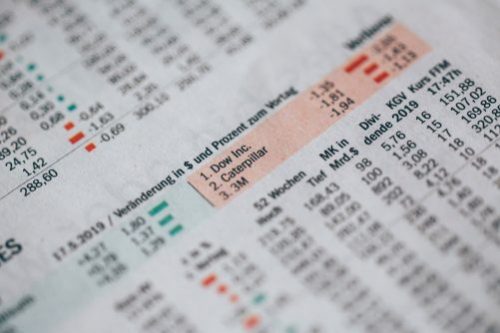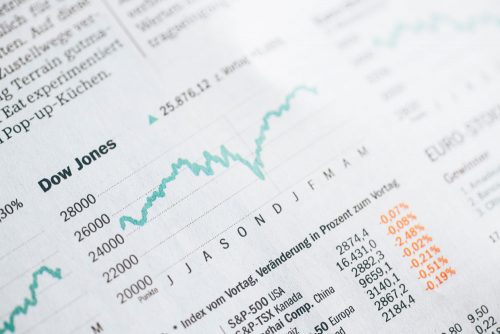
Asset allocation
In the red zone
In the last twelve months the Annualized S&P 500 Return (Dividends Reinvested) has been 37.197%. We are clearly in a bull market; one might even say pretty toppy. It’s a fair question to ask if investors should lighten up on stocks. Let’s think about it.
One of the most important elements of investing is asset allocation. That is, the percent respectively allocated to stocks, bonds and other investment asset classes. Every investor needs to have a clear idea of their asset allocation strategy. It is not something to develop on the fly, especially when markets are red hot or alternatively, in the dumper.
Traditional asset allocation
A traditional asset allocation strategy is a fixed percent allocated to stocks, say 60%; a fixed allocation to bonds, say 35%; and the balance cash or near cash. With this approach, when the percentages change in bull or bear markets, rebalancing is carried out. The only issue is the timing of rebalancing. That can be done once a year or more often. Or it can depend on the percentage of imbalance.
An investor following this approach would already have a game plan around rebalancing in the current bull market. It makes sense. It’s not what I do.
Dynamic asset allocation
This is an allocation and rebalancing strategy that depends on calls about economic cycles. In theory, it is supposed to put investors into sectors such as consumer discretionary, resource stocks, technology or banks in their sweet spot of the economic cycle. It is the epitome of foolish market timing.
Discretionary lightening up
In Irrational Exuberance Professor Robert Shiller wrote, with reference to the stock market’s CAPE ratio: “Long-term investors would be well advised, individually, to lower their exposure to the stock market when it is high, as it has been recently, and get into the market when it is low.” (Shiller, 2005 Second Edition) p187 (Emphasis added)
Let’s dig into the Shiller CAPE a bit more deeply and also reflect generally on price/earnings ratios in the stock market today.
Here’s a current chart of CAPE. It shows CAPE at 36 today. What does it mean?
Data courtesy of Robert Shiller
What is CAPE and where does it come from?
In 1988 John Campbell and Robert Shiller published a paper about price/earnings ratios using a ten-year average. Today Shiller publishes his CAPE, a cyclically adjusted (for inflation) Price/Earnings ratio—sometimes referred to as the CAPE 10. It averages the most recent 10 years’ earnings and adjusts them for inflation.
Shiller says that: “The relation between price-earnings ratios and subsequent returns appears to be moderately strong…” and that, “We believe, however, the relation should be regarded as statistically significant.” (Shiller, 2005 Second Edition) p187
Nowadays CAPE is frequently referred to in analysts’ reports and the financial press in discussions about whether the stock market is expensive and what investors can expect in the years to come. It has a credibility that comes from the fact that its creator Robert Shiller has a high public profile and is a Nobel Prize recipient.
A deeper interpretation of CAPE
The following chart of CAPE comes from an article in the Wall Street Journal, November 22, 2013. It displays what may be Professor Robert Shiller’s interpretation of CAPE as falling into three zones – green, yellow and red.
Robert Shiller was interviewed for the Wall Street Journal article. The CAPE reading at the time of the Wall Street Journal article was 25.2. This was higher than the CAPE long term average of 16.5 shown on the chart. The practical question that day was what actions investors should be taking in their portfolios at this level. The article reports: “’At current levels, it’s a concern,’ said the Yale University professor who last month won the Nobel Prize. It suggests ‘you should reduce holdings a bit, that might be reasonable. In the meantime, it is possible the market could keep going up even more.’”
This yellow zone/red zone interpretation means that one would not be in a true danger zone until CAPE gave a reading over 28.8. A reading of 25.2 (at the time of the article) is pretty well in the middle of the yellow zone. It is not clear whether the green/yellow/red zone distinction is Robert Shiller’s or the Wall Street Journal’s. I doubt the Wall Street Journal would have published the zone colours without Shiller’s concurrence. I do note that Shiller said that the reading of 25.2 was “a concern”. The suggestion, one supposes, is that the stock market at that time was priced fairly richly.
In the red zone
As noted in our current CAPE chart, CAPE is at 36 today, well into the red zone.
One other thing to note. Shiller suggested lightening up on stocks in November 2013. From November 2013 to October 2024 the Annualized S&P 500 Return (Dividends Reinvested) 13.030%. With the benefit of hindsight, any lightening up in November 2013 would have missed out on some great returns.
Discretionary lightening up – discussion
The first thing to note about discretionary lightening up is that it is the practice of market timing. Interestingly, Shiller’s original research did not present CAPE as a market timing tool. The only claim it made was that there was a statistical relationship between CAPE and subsequent returns. It was never claimed to be useful as a timing tool.
The main problem with CAPE today is that it suffers from non-stationarity of its key data input – earnings. Earnings is an accounting term. Over the last twenty-five years reported earnings have become increasingly skewed which, in turn, is skewing CAPE and also the simple price/earnings ratio.
We can let Professor Damodaran explain it. Aswath Damodaran is a professor of finance at the Stern School of Business at New York University. His area of focus is corporate finance and equity valuation. He has been described as the world’s foremost expert on the subject of corporate valuation.
In his new book titled The Corporate Life Cycle – Business, Investment, and Management Implications published in 2024, he writes: “When accountants misclassify expenses…as they continue to do with R&D expenses, a capital expense if you follow first principles but one that is treated as an operating expense – the accounting earnings can be skewed significantly.” (Damodaran, 2024) p.132 (Emphasis added)
So, earnings, the key input into CAPE and price/earnings ratios generally, is skewed and has been becoming more and more skewed over the last twenty-five years.
My view is that lightening up in bull markets is an attempt to practice market timing. It doesn’t work and the metrics like CAPE and price/earnings ratios are, in any event, not good indicators.
Back to basics
Philip Fisher summarizes his approach to selling: “If the job has been correctly done when a common stock is purchased, the time to sell it is – almost never.” (Fisher, Common Stocks and Uncommon Profits and Other Writings. 1958,1996) p113
If the reader hears echoes of Warren Buffett, it’s actually the other way round. As I’ve noted elsewhere Fisher was a great influence on Buffett. See my post: How Warren Buffett was influenced by Philip Fisher
I take this to heart. Our family’s financial assets are essentially 100% in stocks. As described in last week’s post, I only exit the stock market in a generalized true stock market bubble. See Sentiment and the four faces of risk
I periodically trim stock positions because we need money to live on. Those sales are like pruning plants in the garden. I prune portions of the weakest stocks in the portfolio. Each sale serves to make the overall portfolio better and stronger. Any other sales (which don’t take place very often), follow the policies described in this post: 19 Cardinal rules on selling stocks
The last position I eliminated was last July. The stock had become wildly overpriced. I described the sale in this post: Selling a big winner is a tricky decision
Conclusion
The question I started with was whether to lighten up on stocks in the current bull market environment. My simple answer is no. I fully recognize that a bear market will set in at some point. My investment process accommodates the robust swings and roundabouts of the stock market.
+++++++++++++++
You can reach me by email at [email protected]
I’m also on Twitter @rodneylksmith
+++++++++++++++
Want to dig deeper into the principles behind successful investing? Click on the ABOUT tab to read an introduction. It will help readers get the most out of the Nuggets of Investing Wisdom blog.
+++++++++++++++
Check out the Tags Index on the right side of the Home page that goes from ‘accounting goodwill’ to ‘wisdom of crowds’. This will give readers access to a host of useful topics.
+++++++++++++++
You can also use the word search feature on the right-hand side of this page to find references in both Nuggets blog posts and also in the Motherlode.
+++++++++++++++
To explore the Motherlode, click on the Motherlode tab
If you like this blog, tell your friends about it
And don’t hesitate to provide comments or share on Twitter and Facebook

At the time of publishing this post, there are less than 60 days left in 2024. You might want to start thinking about your dreams and goals for the new year. Whatever yours are, I’m going to suggest that learning to master your money should be one of your goals. After all, you’re the person earning the money and you should be firmly in control of what your money does. Trust me. Life is better is when your money works harder for you than you do for it.
There’s no need to wait until January 1 to make the following suggested changes. Believe me when I say that you’ll want to master your money sooner rather than later. Start today.
If you’re a person who likes to make resolutions, then you can implement these three steps on New Year’s Day. Everyone else, I would strongly encourage you to do start following these steps immediately.
Top Up Your Emergency Fund
The goal is to have one year’s worth of necessary expenses set aside. I know that most experts recommend 3-6 months’ worth of expenses. Personally, I don’t believe that this is enough. You’re free to disagree with me, of course. The reality is that it’s better to have a bigger emergency fund than you might need. When your income disappears, you’ll want to have as much set aside as possible to tide you over until you get another paycheque.
Your next job might pay you less than you were earning before. It might take you longer than 6 months to find your next position, or to start earning money from your own business. Being unemployed is a bad situation. Going into debt to pay for living expenses while unemployed makes the situation considerably worse.
Do yourself a favor and set aside more than you need. Your necessary expenses are your shelter costs, your basic utilities, your food, your transportation, your medications, and your phone. If you have pets, then you need to cover their costs too. Everything else should be put on hiatus until you get another source of income.
For most people, it will take some time to hit this target. Setting aside a year’s worth of expenses won’t be quick. There will be many, many temptations along the way to spend re-direct money away from the task of building your emergency fund. Do yourself a favor. Set up an automatic transfer from your chequing account to your emergency fund. This way, you don’t have to think about funding your future emergencies as it will happen automatically through the magic of technology.
Invest Your Money
First things first – track your expenses. Ideally, you’ll do this for a month. Write down what you spend. Figure out which expenses were necessary (see above) and which ones weren’t. Of the second group, identify the ones that don’t make you happy and promise yourself to eliminate those ones in the future.
Whatever money is cut needs to be re-directed towards your investment portfolio. Your investment portfolio consists of registered accounts and your brokerage account. Your registered accounts are your Tax Free Savings Account (TFSA) and your Registered Retirement Savings Plan (RRSP).
Fill your registered accounts before you start contributing to your brokerage account. The TFSA will not generate a tax deduction but the money will grow tax-free forever. You can also withdraw money from your TFSA without paying taxes. The RRSP money is tax-deductible, and money inside an RRSP will grow tax-free. Once you start to withdraw the money, you’ll pay taxes on it. Fill your TFSA to its limit, then focus on filling your RRSP.
Once you’ve filled your registered accounts, then you can open a brokerage account and re-direct your investment contribution. Money invested in your brokerage account is not tax-deductible, and you do have to pay taxes on it every year. Ideally, you’ll be investing in securities that generate dividends and capital gains for you. Dividends and capital gains are not taxed as heavily as interest earned in a bank account or from GICs.
Follow this order of investing every year: TFSA -> RRSP -> Brokerage Account.
If you’re starting from scratch, it might take you a few years to fill up the registered accounts. That doesn’t matter. You’re trying to build a nice, fat money cushion for Future You. Consistency is key, so don’t worry about how long it will take. Just start today and don’t stop.
Pay Off Debt
Ridding yourself of debt is just as important as long-term investing. I don’t want you sacrificing one for the other because you need time on your side. You need to have money invested so it can compound for as long as long possible. This is why you should be investing at the same time that you’re paying off debt.
After you’ve eliminated the debt, you will have a hard-working investment portfolio in place. This is a wonderful thing! It means you won’t be starting from $0 if your debts aren’t gone until you hit your 50s or 60s.
Tighten your belt and learn to say “No”. If you have debt, then I want you to do the following.
Take half of your contribution amount and direct it towards your debt. Allow me to be very clear. You’re already paying the minimums on your debts every month. Half of amount that would’ve otherwise gone to your investments will be added to the minimum payment of one of your debts. An increased payment dramatically shortens the time it will take to pay off a debt. Once debt #1 is gone, add that entire former payment from debt #1 to the minimum payment of debt #2. When debt #2 disappears, add the entire former payment that was going to debt #2 to the minimum payment for debt #3. Repeat this cycle until all of you’ve paid off all of your debts.
Do not get bogged down in deciding whether to use the Debt Snowball Method or Debt Avalanche Method. It truly doesn’t matter. The only thing that matters is your decision to start paying down your debt today.
Both methods will get your out of debt. Personally, I like the Snowball Method since it eliminates the smaller debts first. Paying down debt sucks, so seeing wins as soon as possible makes people feel good.
Once you’ve paid off your debts, take the former debt payments and re-direct them to your registered accounts and your brokerage account.
That’s It. That’s the Plan.
Once you’re out of debt, stay out. Save up for large purchases so that you don’t have to finance them. The one exception is your mortgage. Even I will admit that this is the one purchase where financing is nearly unavoidable without a lottery win, a big insurance settlement, or an inheritance.
Keep your emergency fund fully-funded. If you need to use it, then make it a priority to build it back up again. Life can be funny. There’s no rule saying that only one emergency is headed your way.
Invest for the long-term. Put your money into well-diversified, equity-based securities. Personally, I like exchange traded funds (ETFs) more than I like mutual funds. For nearly the same security, ETFs will cost you atleast 80% less. Read The Simple Path to Wealth by JL Collins. While it’s written for an American audience, the savings & investing principles are equally applicable to Canadians.
You’re already doing all of these things, you say? Fantastic! Use this time to tweak your system, if necessary. Consider increasing your emergency fund by 3%, just to keep up with inflation. It’s never a bad idea to increase your contributions to your brokerage account by an additional 1%. Taking this step every year will make a big difference in how much your accumulate. It bears repeating – once your debt is gone, keep it gone.
That’s it – that’s the plan to master your money. If you do these three things, then you’ll be setting yourself up for success.
Everything else is details.
The post Three Simple Steps to Master Your Money. appeared first on Millionaire on the Prairie.

This issue is entirely focused on the energy sector, considering both Oil & Gas and Low Carbon alternatives. Grab your coffee and dive in!
The post [PREMIUM] A deep dive into BP| Newsletter #025 appeared first on European Dividend Growth Investor.

You may have noticed that there was an election in the U.S. this past week. Donald Trump will be returning to the White House. As comedian Bill Maher joked, Americans never turn down seconds. The good news is, it was a convincing victory. There will be a peaceful transfer of power. Others will say, the bad news is – it was a convincing victory. But the thing is, it doesn’t matter what we say, the voters have spoken, loudly. America and the world will have to deal with it and move on. And with respect to your portfolio, it simply doesn’t matter over the longer term who is in power. The American economy is a much more powerful force than any sitting President. That said, the markets certainly voted and they like the prospect of lower taxes and less regulation. The U.S. stock market has the best week of the year on the Sunday Reads.
On Seeking Alpha I offered (before the election day) Democrats’ stock returns beat Republicans’, but it still doesn’t matter who wins with respect to the markets, and investing.
Here’s the key chart / Tweet from the post …
Here’s the very hot heat map for the week …
We see the growth stock surge and most of the defensives are cold. That’s good news for retirees and near retirees of course. You can take profits for spending, and you can also move profits from growth to defensives or cash/bonds, if your weightings dictate.
It’s all good news for accumulators, you’re making more money.
Election recap
On Wednesday, the stock and bond markets cast their first ballots on the next four years. Stocks moved higher, as did long-term interest rates. The S&P 500 was up 2.5 per cent, the Nasdaq Composite was up 3 per cent.
The S&P 500 soared 4.66% for the week to end at 5,995 posting gains in four out of five sessions.
U.S. bonds sold off on Wednesday but recovered through the week, up modestly for the full week.
Trump’s potential tax cuts mean larger deficits for a government whose budget shortfall is already massive. The Congressional Budget Office puts this year’s deficit at US$1.9-trillion, or 7 per cent of gross domestic product. Canada’s federal deficit this year is budgeted to be 1.4 per cent of GDP, falling to 0.6 per cent in the 2028-29 fiscal year.
Economists have suggested that the Republican platform will increase the deficits much more than would have the Democrats’.
If we try to frame the Trump regime in a ‘dumbed down’ sentence – economy good, debt bad.
With respect to some of the Trump policies that might hurt the economy longer term (mass deportations and massive across the board tariffs), we’ll have to wait and see. In November of 2024, we honestly have no idea what the Republican administration can do, or will want to do on those fronts.
Of course, the tariffs (taxes) have the potential to be inflationary. The Committee for Responsible Federal Budget estimates that under Mr. Trump, the midpoint of his promises would deliver deficits of “9.7 per cent of GDP in 2035, with a range of 7.7 to 12.2 per cent of GDP in other scenarios – the highest levels reached outside of a war or recession.”
Sectors for the week
- #1: Consumer Discretionary +7.62%
- #2: Energy +6.16%
- #3: Industrials +5.93%
- #4: Financials +5.53%
- #5: Information Technology +5.44%
- #6: Communication Services +4.09%.
- #7: Real Estate +2.68%
- #8: Health Care +1.57%
- #9: Materials +1.46%
- #10: Consumer Staples +1.20%
- #11: Utilities +1.19%
Bitcoin was up 10% for the week (it’s up much more into the weekend). Trump is seen as bitcoin-friendly.
Gold softened but has been on an incredible run.
- Canadian stocks (XIC.TO) were up 2% for the week.
- International stocks (EFA) were down 0.75%.
If you hold an asset allocation ETF you are participating big time as the U.S. market dominates the global equity indices. iShares XEQT was up 3% for the week. That managed global ETF portfolio is up 24% in 2024, and 31.55% over the last year.
More on rebalancing portfolios
At the Globe & Mail, Rob Carrick looked at rebalancing and the weight of U.S. stocks in various funds.
We’ll look at balanced portfolios, with a rough mix of 60-per-cent stocks and 40-per-cent bonds, as a point of comparison.
The Roboadviser Justwealth’s global balanced growth portfolio has an overall 28-per-cent portfolio weighting in U.S. stocks, while Wealthsimple’s classic balanced portfolio has a U.S. equity weighting of 18.5 per cent.
Among asset allocation ETFs, the Vanguard Balanced ETF Portfolio (VBAL-T) has a 27.4-per-cent weighting in U.S. stocks, the iShares Core Balanced ETF Portfolio (XBAL-T) has 28.4 per cent in U.S. stocks, the Fidelity All-in-One Balanced ETF (FBAL-NE) has 30 per cent and the TD Balanced ETF Portfolio (TBAL-T) has 25 per cent.
Check out the total return comparisons on the Canadian Asset Allocation ETF page.
Among mutual funds, the Mawer Balanced Fund has a 15.3 per cent U.S. equity weighting, while the massive RBC Select Balanced Portfolio has 25 per cent.
On Cut The Crap Investing, and for the Core Balanced ETF Portfolio, I have the U.S. stock weighting at 30%. I’ve long had a bias for U.S. stocks of course.
The U.S. is where they keep most of the best companies on earth.
Dale (Cut The Crap Investing)
And while the U.S. markets are expensive, it is still where they keep the growth. In a growth-scarce world, investors are willing to pay up for current growth and future growth prospects …
While I was writing for MoneySense I offered that growth will be scarce, and of course we want to own enough of the growth that exists.
Bitcoin is scarce, gold is scarce and the U.S. is certainly where they keep the earnings and revenue growth. Investors are seeking scarcity.
When to rebalance your bitcoin position
I did hear from a reader or three on the size of their bitcoin position. Should I sell some? goes the question.
Of course, it all depends on your desired asset weight. It could be 2%, 3%, 5% or more. It all depends on your tolerance for risk and your conviction for the asset. If your target was 5% and it has moved to 7% or more, then sure take some profits. It is such a volatile asset so rebalancing is key in a portfolio setting.
If you don’t have a portfolio weighting target, adopt one now.
I’d suggest we’d need to go to 2-3% as a minimum so that any major move over the years and decades will have an impact on your portfolio and your life.
I’m more than happy to collect fees (tolls) on the bitcoin ETFs and the market by way of owning BlackRock (BLK), one of my 3 U.S. stock picks. The others are Apple (AAPL) and Berkshire Hathaway(BRK.B).
This is a popular image this week.
Of course, bitcoin could be $100,00o or $30,000 by the time this post gets to digital press, ha Bitcoin tacked on another 4% or so this weekend.
You’ll find gold and bitcoin as considerations in the new balanced portfolio.
The low liquidity issue for XDU
I created a sizable position in iShares U.S. Quality Dividend ETF XDU.TO. That’s a Canadian Dollar ETF that invests in U.S. quality stocks. I like the defensive sector arrangement, low volatility and favourable valuation. It complements our U.S. stock portfolio.
Given that it is a Canadian Dollar ETF, the fund will pay the withholding taxes on U.S. Dividends. Given the modest yield it is a very minor event. I see no problem using that in any account from RRSPs, RRIFs, TFSAs and Taxable.
A few readers asked about the ‘low liquidity’. Please have a read of – Ever wonder who makes your ETFs and how they stay on track?
You’ll see that an ETF is not priced on supply and demand. An ETF is priced by value of the underlying assets – the stocks and bonds in the fund. There is ample liquidity in the stocks of XDU – Exxon Mobil, McDonald’s, Coca-Cola, Johnson & Johnson, etc. etc.
Low trading volumes are not an issue.
Telus calls to say – “I’m OK”
And finally some good news in the Canadian telco sector. Telus offered some solid news. Of course, you could frame things to sound very attractive as management did.
Meanwhile BCE continues to go in the wrong direction IMHO. Instead of paying down debt and cutting the dividend they are increasing debt and holding the dividend. I’m glad to hang up on Bell. I also sold half of my Telus in previous months. My wife still holds Telus and Quebecor in her Canadian stock portfolio.
The telco sector has had a rough ride. Hopefully more stability returns as they cut costs (payrolls and CapEx) and get some help from a lower rate environment.
It would be great if they went back to being boring slow growth companies.
More Sunday Reads
At Findependence Hub Jonathan Chevreau looks at Trump 2.0.
At Dividend Hawk you’ll find a summary of important and interesting news and events over the last week related to his portfolio holdings. Plus notable articles from other websites that caught the Hawk’s eye.
That includes a look at Qualcomm (QCOM), one of my own growth holdings. The stock has been on an incredible run and received another boost.
QCOM reports fourth quarter Non-GAAP EPS of $2.69, 33% above from last year and $0.12 more than expected. Revenue grew 18.1% to $10.24 billion, topping estimates by $310 million. For Q1 FY25 Management guides Revenue of $10.5B-$11.3B and Non-GAAP diluted EPS of $2.85-$3.05. Management has also approved a new $15.0 billion stock repurchase authorization.
You’ll see some earnings overviews on several Canadian stocks as well. From TC Energy to Manulife.
Banker on Wheels always cycles through a rich mix of posts and podcasts.
Here’s how Banker broke free from the hampster wheel known as a corporate career.
Also in the post, take a look at the idea of ‘mini retirements’.
That’s a theme that I embraced and enjoyed a few times through my 40’s and 50’s. I put much more value on family time and health over endless corporate ladder climbing.
And, where does economic growth come from?
Someone who’s doing it right – Bob at Tawcan looks at their future travel plans.
Join Cut The Crap Investing
You can follow this blog, it’s free. New posts, plus other free content and ‘ideas’ will be delivered to your email inbox. Enter your email in the subscribe area, or ‘join us today’ on the home page.
ETFs / Stock Portfolios / Retirement Strategies / Wealth Creation
Thanks Partners
Earn a break on fees by way of many of these partnership links.
CANADA’S TOP-RANKED DISCOUNT BROKERAGE
Cut the Crap Investing readers can earn a break on fees at Questrade by way of that partnership link. At Questrade, you can buy ETFs for free. It’s a great place to build your stock portfolio.
Here’s Canada’s top-performing Robo Advisor, Justwealth. You can get advice, planning and low-fee ETF portfolios all at one shop. Yes, you can have it all.
Consider Justwealth for RESP accounts. That is THE option in Canada with target date funds that adjust the risk level as the student approaches the College or University start date.
OUR SAVINGS ACCOUNTS
Make your cash work a lot harder at EQ Bank. RRSP and TFSA account savings rates are at 2.5% and 3.0%. You’ll find some higher rates on GICs up to 4.50%. They also offer U.S. dollar accounts. We use EQ Bank, they have been awesome.
OUR CASHBACK CREDIT CARD
We make between $40 to $70 every month! And that’s on everyday spending. There are no fees with …
The Tangerine Cash Back Credit Card
For September we received $51.44 in cash. You can select 3 categories for 2% cash back.
That cash went into my TFSA account to buy some bitcoin.
While I do not accept monies for feature blog posts please click here on the mission and ‘how I might get paid’ disclosures. Affiliate partnerships help me (try to) pay the bills for this site. But they don’t, ha. That will allow me to keep this site free of ads and easy to read.
The post The U.S. stock market has its best week of the year on the Sunday Reads. appeared first on Cut the Crap Investing.

The month of October 2024 is another month of dividend income landing in my accounts.
Due to becoming debt free, I changed my pay myself model. Starting the beginning of August 2021, I am paying myself 30%, just like before. This will now consist of 24% to investing, and 6% to savings. The investment portion is going to my TFSA. Any money left over at the end of the month, I put towards investing on top of the money allocated from paying myself first. Hopefully, I can keep this up!
Note: All the dividends and totals below are in Canadian Dollars
I received a total of $1451.79 in dividend income for the month of October 2024. This represents a 0.187% increase from 3 months ago and a 53.6% increase year over year.
I received $0.00 in option premiums within my investment accounts in October 2024.
Below is a visual of my dividend totals for the last 5 years.
| Ckick To Enlarge |
| Click To Enlarge |
| Click To Enlarge |
Note: Any activity in my RRSP account is not included in these totals.
How was your dividend income for October 2024?
Disclosure : Long all mentioned securities
DISCLAIMER
I am not a financial planner, financial advisor, accountant or tax attorney. The information on this blog represents my own thoughts and opinions and should NOT be taken as investment or business advice.
Every individual should do their due diligence to make their own financial decisions based on their financial situation and tolerance for risk.

Freelance income to the rescue
For 2024 I’m publishing side income reports each month to maintain accountability.
My goal is to progress by keeping it transparent and real. Reporting on the good and the bad lets me reflect on lessons learned.
Which sources I’m reporting and which I’m not
I’m not posting anonymously so my main job income, my part-time job income, and my main investments won’t be reported. I’ll report everything else, though!
Some income will be reported when I cash out, and others as I earn it. I’m moving toward
Also, for the moment I’m reporting income, not profit. I’m in the red overall and will be for some time.
With that, let’s get going!
Google AdSense income: $10.50 (-$1.68)
October saw a modest downtick in Google AdSense income.
I reduced the number of ads showing on the page in June. I turned off Auto Ads on my main blog because the ads dominated the site and overran the content.
I have noticed more sign-ups for my newsletter from the blog, which is a positive. Also, the better site experience seems to be reflected in the traffic!
I applied for AdSense on my online presence blog but it hasn’t been approved yet. It could be anything at this point, but it may be navigation that’s causing the issue.
Google AdSense income has been there for most of my blogging run. Even though it’s been way higher than it is now, with the blog just mostly sitting there, people continue to visit and interact with the ads.
Medium Partner Program income: $11.40 (+$8.50)
October Medium Partner Program income finally went back up, after four months of decline.
I published six articles in October, as opposed to ten the previous month.
I currently stand at 111 articles.
Mr. Rebates: $1.39
Mr. Rebates is a cash-back rebate site that I’ve used for nearly two decades. People simply sign up for a free account, click through to online stores, and get a percentage back in their account.
Mr. Rebates rewards members with 20% of what their referrals earns, for life.
(Note, the link above and others in this article are affiliate links, which means that if you sign up I stand to earn a commission, at no additional cost to you.)
All income recently has been from referral commissions. I have a handful of dedicated referrals that continue to buy through the site, so I benefit from their activity rather than my own.
Inbox Dollars: $10.00
Inbox Dollars is a get-paid-to site that pays out cash for surveys, trials, sign-ups, and other activities. June’s earnings were roughly the same as May’s.
Inbox Dollars pays 10% of my referrals’ earnings for life. Like Mr. Rebates, most of the income comes from a couple of very active referrals, and it’s been reliable for quite some time.
I was able to cash out a $10 virtual MasterCard from Inbox Dollars in October.
Amazon Associates: $0
No commissions in October but I did get some sales on Halloween which showed up as commissions for November.
Landa: $0.65
Landa offers shares of rental properties in several states. These shares pay “dividends” each month, based on the net income the underlying properties bring in.
I put $250 in for fun to see where it goes.
I plan to buy more shares as I earn enough from dividends, but don’t plan to put more money in unless the prices dip substantially.
Atlas Earth: $10.00
Yeah, I started watching ads again on this app for money.
But hey, $10!
Receipt Hog and IBotta: $51.15
I have several grocery receipt apps that I “stack” for receipt rewards. This is completely legit.
I got payouts this month from two of them: $25 from Receipt Hog, and $26.15 from IBotta.
EarnApp: $8.03
EarnApp is about as close to passive income as you can get for an app. It runs on my computer, transfers anonymized packets from one place to another, and I get paid for allowing this.
There’s no intervention on my part, and I hardly notice the performance hit.
I have 72 referrals now, and 13 of them have installed the app and used it for long enough to generate some referral income. The referral income is 10% of their income for life (at no cost to them as it’s baked into the rate everyone gets).
The minimum payout is $2.50 (minus a very small fee), so the referral right now will get me to that $2.50 slightly faster. Most of the income this month, like last month, was from the app “working” on my computer.
I received three payments in October.
I talk more EarnApp and other very passive income sites here.
Honeygain: $0
HoneyGain is a site similar to EarnApp. I share my bandwidth and I get paid.
I have eight referrals now and one of them appears to be running the app a lot, so the referral income is up a bit (though the total is barely a dime now).
I may reach payout ($20) by the end of November.
Piano lessons: $80.00
This year I’ve driven a few miles to give a one-hour piano lesson.
I was able to do two piano lessons this month.
It has been enjoyable for both myself and my student. Not bad as far as trading time for money goes!
This is my favorite side income currently because of the interactions, to be fair. Not at all passive, but that’s just fine!
Website services: $160.00
This one started out of the blue a bit!
A poker player I’d met and visited his Kick channel wanted a website, so I did that for him! To be fair, I had followed his Kick channel, provided some tips for promoting his Kick channel, and chatted with him a lot before it got to that point, but it paid off.
Of this $160, $30/month will be recurring for website maintenance and hosting. The other $130 was for design and writing articles.
Global Poker: $51.36
I had a cashout in October at Global Poker.
I play for fun. I have enough of a winning record on micro-tournaments and $0.05/$0.10 cash games to not go broke. Also there’s a small daily sign-in reward that subsidizes my playing.
I talk more about how I earn regularly from online poker here.
TOTAL: $394.48 (+339% from last month)
Thanks mainly to my freelancing income this month, this was my best month to date this year!
Other sources that are waiting in the wings
I have a few others that I’m involved in. Some will pay out soon:
- MyPoints: a site similar to Inbox Dollars (owned by the same company)
- Swagbucks : another site similar to Inbox Dollars (owned by the same company)
- Impact and FlexOffers, similar to Commission Junction
- Kit, the mailing list manager extraordinaire
- Tutoring (in real life!)
- Honey: A completely different app than HoneyGain; used for coupon codes
- CryptoTab: a browser that mines bitcoin
- InstaGC: a site similar to Inbox Dollars (NOT owned by the same company)
- My YouTube channel (67% toward 1,000 subscribers and 18% of the way toward 4k hours)
- Selling on eBay
- Benable with its swanky lists and built-in affiliate program
- Quora! I’m writing there again.
We can only start from where we are.
The best time to start earning side income was twenty years ago.
But the next best time is right now.
Let’s encourage one another. Let’s do this together!
Thanks for reading!
Hi, I’m John and I encourage entrepreneurship in people, including myself.
Join 300+ savvy people with my Solid Cash Tips newsletter for regular insights on side hustling and saving money, with a generous portion of productivity, habit-building, and working smarter!
Visit Mighty Bargain Hunter for more articles on recognizing life’s good deals!

Results powered by dfin.pro. Please note that this tool is for educational and informational purposes only. If you notice any errors or unexpected results, please do send us an email or leave a note in the comments below. Interested in some common currency conversions that people are searching for? Try these: Before You Go… Hopefully you found […]

There is always another rainbow. – Scrooge McDuck
The IRS has updated the new contribution limits for retirement plans. The annual limit on elective deferrals will increase to $23,500 (up from $23,000) for 401(k), 403(b), and 457 plans, as well as SARSEPs, and to $16,500 (up from $16,000) for most SIMPLE plans and SIMPLE IRAs.
That’s great news!
If you can max out your 401(k) with a 10% return, you would have $1M in 17 years. It would only take you an additional six years to get to the next million. You would then be a multimillionaire.
I know what you’re thinking.
How on earth am I going to get to one million let alone two million.
Just hear me out.
Let’s talk about how you can start with nothing and end a millionaire.
I will take you through the origins of a pension and ending with the rise in the 401(k).
Think of it like a roller coaster ride.
Deciding to strap in your seatbelt is the hardest part. It’s getting down the first hill that scares us and then after that it’s pretty much smooth sailing.
What is a pension? A pension plan is a retirement plan that provides a regular income to an employee after they retire. The employer is responsible for managing the investments in the plan and bears the risk of market decline.
Pensions have been around for a long time, with origins dating back to the classical world and before the United States was founded. The first military pensions were adopted in the United States, and the first veterans’ pension was offered to retired naval officers in 1799.
In 1875, the American Express Company established the first private pension plan in the United States, and, shortly thereafter, utilities, banking and manufacturing companies also began to provide pensions.
However, pensions go back even further. All the way to ancient times.
In the Roman Empire, veteran legionnaires received military pensions in the form of land grants or special appointments. This sort of barter system was still going around 50 B.C., when Roman soldiers were paid in salt, a highly valued commodity at the time.
Even the word salary comes from ancient times. The word “salary” comes from the Latin word salarium, which means “salt money. In ancient Rome, soldiers were paid in salt, a valuable commodity used to preserve food. The Latin word sal means “salt”. The word salarium continued to be used to refer to soldiers’ pay even after other forms of payment were introduced.
The word salarium entered the French language as salaire, and then into English in the late 13th century as salarie. The Norman conquest in 1066 introduced many Latin-derived words into the English language, including “salary.” That was during the time of William the Conqueror, but that is another story.
Have you ever heard the saying about being “worth your salt”? Now you know where it came from.
And just in case you were wondering, no, Social Security is not the same as a pension. That is a social insurance program started by Franklin Roosevelt (FDR) in 1935. Social Security is a social insurance plan that is intended to supplement a retired worker’s pension and savings.
Social Security is an earned government benefit for seniors, people with disabilities and children who have lost a working parent. Working people contribute to Social Security with every paycheck. A pension is income you set aside while you’re working so you will be able to get a monthly paycheck when you retire. Pensions have vesting periods and Social Security does not.
Pensions became popular after the Second World War in the 1940’s and through 1970 when as many as 52% of workers had them. Employers managed the program, but they also took on the administrative cost burden and risk associated with them. Then, sadly, pensions started going the way of the dinosaur and Atari game console.
The 401(k) is the PlayStation 5 of our day and bumped out the pension, which is the Nintendo of days past.
Today, about 10% of private employers offer pensions. This started being replaced by the 401(k).
One of the biggest silver linings of having a 401(k) versus a pension is the fact that a 401(k) cannot go bankrupt. However, a company can and once that happens they are under no obligation to pay pension benefits; whereas, your 401(k) travels with you wherever you go like a passport.
A silver lining is a positive aspect or sign of hope in a situation that might otherwise be negative. It’s often used in the proverb “every cloud has a silver lining,” which means that there’s always something good or hopeful to be found in even the worst situations.
Now, that you know more of the history of pensions, let me show you how you can start with nothing and rise to the top just like Jennifer Lawrence in the Silver Linings Playbook. She may be a top paid leading lady in Hollywood now but as a broke teenager starting out, she had nothing.
Actress Jennifer Lawrence at the Red Sparrow premiere in New York on February 26, 2018. REUTERS/Caitlin Ochs
She grew up in Kentucky in a middle-class family and had a middle-class upbringing. Growing up she often felt like a misfit as she did not fit in with her peers.
I can relate to that on some level as I was always striving to get the gold star on the behavior chart every day at school. I was less impressed with class clowns, popular kids or jocks and more focused on reading and getting into college. My parents called me the rebel of my four siblings. I didn’t care. I know I was meant for something else. I wanted to be a writer and a rich businesswoman. Just like Jennifer, I was charting my own path.
After a talent scout spotted 14-year-old Jennifer while on vacation, she told her parents she wanted to pursue acting. She then worked on leaving school and got her GED so that she could start auditing for parts.
She actually audited for the role of It-girl, Serena van der Woodsen, in Gossip Girl, but lost the part to Blake Lively. She has said she was really bummed not to get the part. However, as one door closes, another opens.
She got her first paid role in 2006 and a small part as a mascot in an episode of Monk. However, the movie that got her the buzz she needed to get cast in bigger films was when she got cast for the leading role in Winter’s Bone. Lawrence’s acting amazed critics and audiences alike. I saw the film and I knew instantly that a star was born.
At only 20-years-old, she earned an Oscar nomination for Best Actress in a Leading Role. And from there, Lawrence’s success continued to skyrocket.
In 2011, she landed the role of Mystique in Marvel’s X-Men: First Class.
In 2012, she wowed audiences as Katniss Everdeen in The Hunger Games. The post-apocalyptic, dystopian film was an instant hit. This is the film where she earned her first $1M paycheck. The first women to ever get that million was none other than Elizabeth Taylor for the 1964 film Cleopatra. Jennifer was in good company.
Later in 2012, Lawrence starred in another successful film, Silver Linings Playbook. She won an Oscar for Best Actress for her performance. And at the time, she was the second-youngest actress to achieve this honor. Lawrence was only 22.
If you think her rise to superstardom was fast, then think again. She doesn’t owe any of her success to luck. She worked hard for her multimillion-dollar salary.
In Jennifer Lawrence’s own words: “I put in my time; I lived in a rat-infested apartment when I was 14, and I was told ‘No’ many times. I put my blood, sweat, and tears into all of this. It’s easy to look from the outside and see my career grew very fast, but there was a time before that career when I was working for it. And I definitely wouldn’t have wanted that time to go on any longer.” I feel her on that.
I lived in small apartments, ate ramen for dinner and had times that I lived off of $5 a day. It was only after I put in my time that I was able to negotiate a six-figure compensation package later in my career and started investing upwards to $10,000+ per year, that I started to see some return on my own sweat and tears.
Here is a peak behind Jennifer Lawrence’s financial playbook:
Here’s how she made from playing Katniss and Mystique in these franchises:
- The first Hunger Games installment paid her $1 million. She earned $10 million for the second film and $20 million apiece for the third and fourth movies.
- As Mystique in the X-Men franchise, Lawrence earned $250,000 for First Class, $6 million for Days of Future Past, $8 million for Apocalypse, and $4.7 for Dark Phoenix.
On average, Jennifer Lawrence earns between $15-$20 million per movie. Her paychecks for a few of her films were:
Passengers (2014): $20 million
Don’t Look Up (2021) $25 million
Red Sparrow (2018): $20 million
Jennifer also has other sources of income such as endorsement deals.
In 2012, she became the face of Dior. The luxury brand paid the actress a cool $20 million.
She owns a production company.
She is also a landlord. owns a luxury apartment in Manhattan. She paid $9 million for the unit and now rents it for around $27,000 monthly.
What I have learned from her story is that you have to create opportunities for yourself by showing up and doing the work. Success is not just going to fall into your lap. You have to go get it. Success not only attracts success, but it also leaves clues.
In order to earn her first million, Jennifer Lawrence had to act in numerous plays, move to New York, get an agent, audition for dozens of film and television roles, learn how to become an archer, sit in a makeup chair for 3-6 hours to be painted blue everyday on set for weeks and months and work out 1.5 hours a day for months on end over about a decade time period. Nothing happened by accident. It was intentional.
You must use your 401(k) in the same manner.
I waitressed, was a phone operator, a gas station attendant, scrubbed toilets, working all the while earning a bachelor’s and Master’s degree, read about 15 personal finance books a year, started a blog and was promoted numerous times at different companies to get to where I am today.
My first million is so close I can feel it tapping me on the shoulder.
When Business Insider did my story, I was at $375,000 in investable assets. I have since seen had my investments grow to $422,000. My $500,000 journey is rapidly coming to an end. Compound interest is barreling me toward the finish line. Depending on market fluctuations, I will hit my target of $500,000 in 365-500 days.
A company going bankrupt cannot blow up my retirement. My pension cannot be taken away from me the same way Lucy takes away that football from Charlie Brown. My 401(k) is mine forever. Just let that silver lining sink in.
About The Author
Miriam started Greenbacks Magnet in 2016 to keep a scorecard of her goal of $1M in investable assets. Armed with a Master in Management (MiM) and a calculator, she teaches readers how to achieve financial independence while also helping them learn how to smell the roses along the way. The palpable response she got from sharing her personal finance goal in a public speaking course at Georgetown University encouraged her to share her story and teach finance on her website. She invests in AI companies as artificial intelligence is the new iPhone of the moment as she likes to invest in companies that are disruptive.

Five years ago (and that just feels crazy to type), I decided it would be fun to publish a short bucket list of life goals to accomplish before I turned forty for Blogtober. Now that I’ve met that mid-life milestone, I thought it’d be fun to revisit that list and see where I’m at. I would also like to note …
The post SO I TURNED FORTY: REVISITING MY BUCKET LIST appeared first on a life on a dime.

Save, invest, prosper with My Own Advisor.
Weekend Reading – How to safeguard your retirement plan Hey Everyone, Welcome to a new Weekend Reading edition on the subject of how to safeguard your retirement plan. While I’m still catching up from my vacation, a bit, including answering reader emails, I’m now up to date for all comments on this site. That said,…
Join the million dollar portfolio journey. The article Weekend Reading – How to safeguard your retirement plan is exclusive to My Own Advisor. All Rights Reserved.
